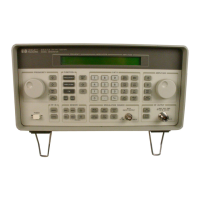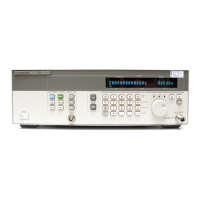8-48
Performance Tests
Internal Timebase: Aging Rate Performance Test (Option 1E5 Only)
Time/Division: 5 ns
4. Trigger:
Trigger Source: CH 2
Trigger Mode: Normal
Trigger level: 0V
If the signal drifts a full cycle (360°) in less than 2 minutes, refer to Chapter 7 and
perform the “Internal Reference Oscillator Adjustment.” After the adjustment, restart
this performance test.
Measure the Phase Change Time
1. Monitor the time and the display. Note the time required for a 360° phase change:
T1 = ________(s)
2. wait 3 to 24 hours. Note now long you waited:
T2 = ________(h)
3. Repeat step 1. Record the phase change time:
T3 = ________(s)
4. Calculate the aging rate as follows:
Aging Rate = (1 cycle/10 MHz) (1/T1 − 1/T3) (24 hours/T2)
Example:
T1 + 351 seconds
T2 = 3 hours
T3 = 349 seconds
= (1 cycle/10 MHz) (1/351s − 1/349s) (24h/3h)
= 1.306x10
−11
per day
5. Record the test results and compare the results to the limits in the test record.
NOTE If the absolute frequency of the standard and of the timebase oscillator are
extremely close, you can reduce the measurement time (T1 and T3) by
measuring the time required for a phase change of less than 360°. In step 6,
change 1 cycle to 0.5 cycle for 180°, or 0.25 cycle for 90°.
Test Record
• 8648A Option 1E5: Table 8-19.
• 8648B Option 1E5: Table 8-44.
• 8648C Option 1E5: Table 8-69.
• 8648D Option 1E5: Table 8-94.

